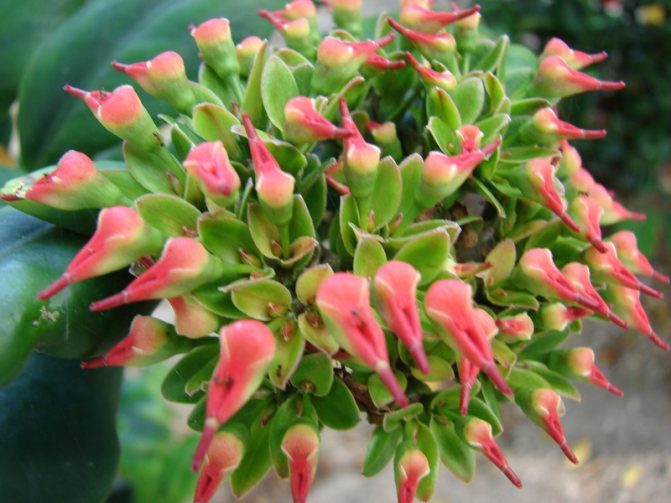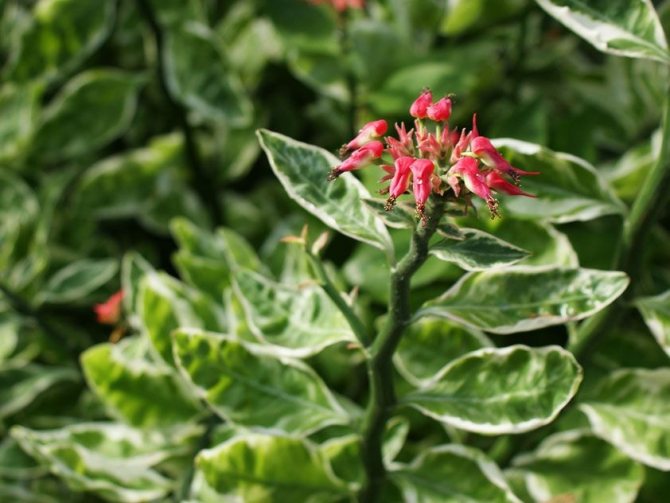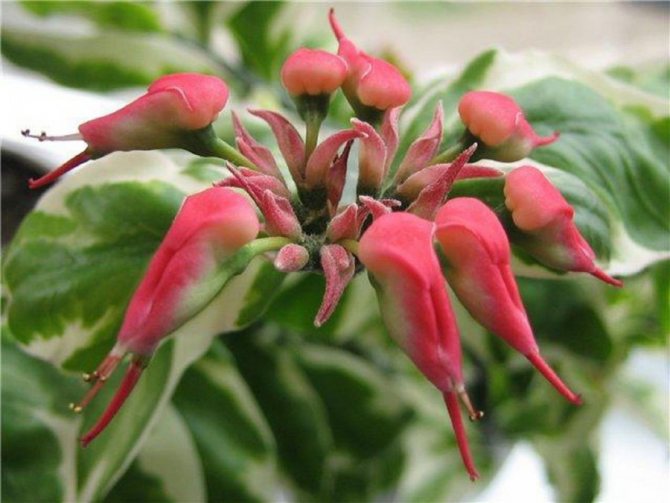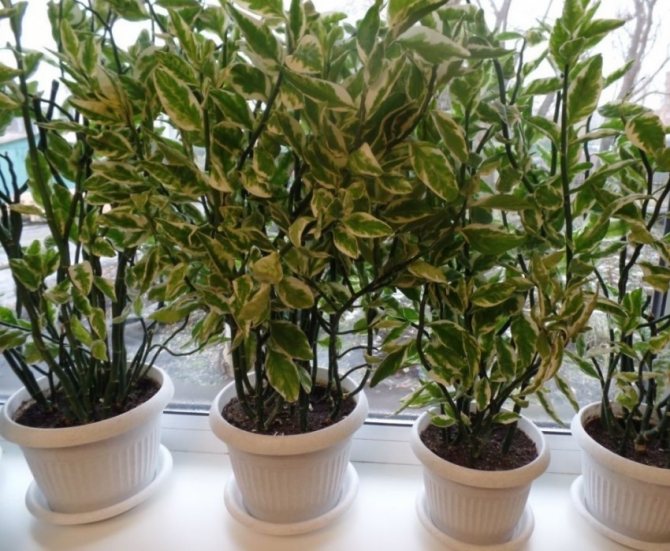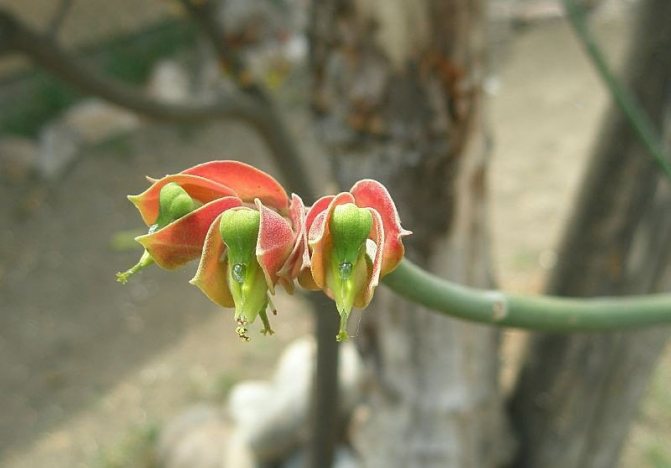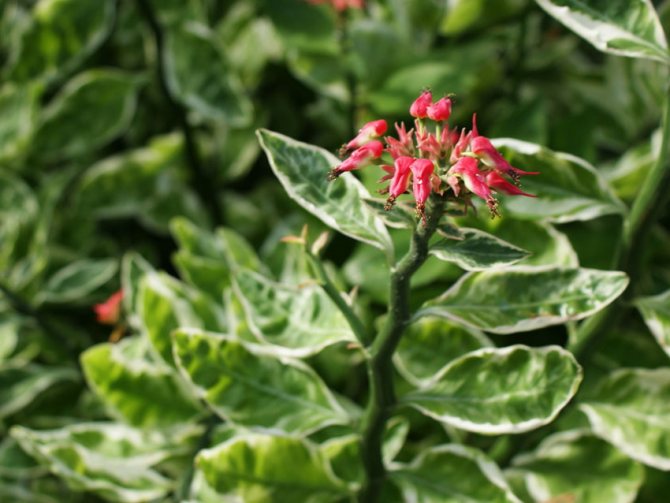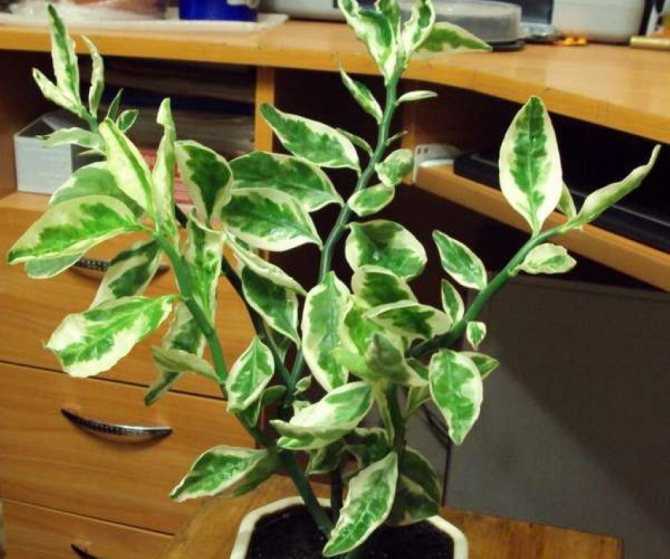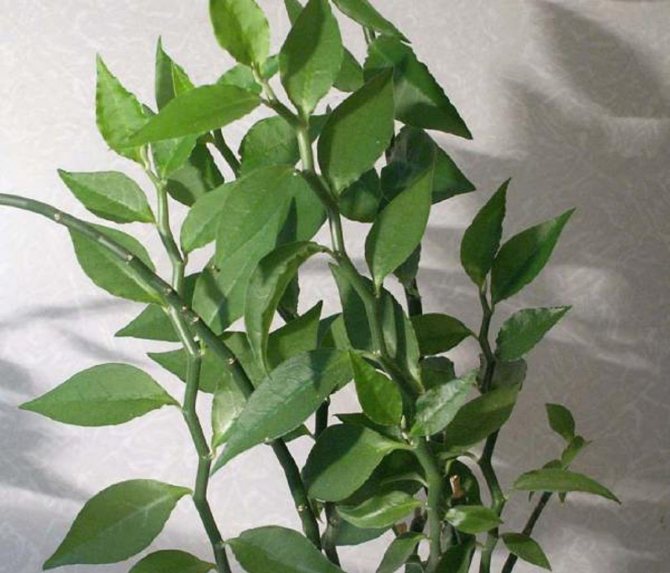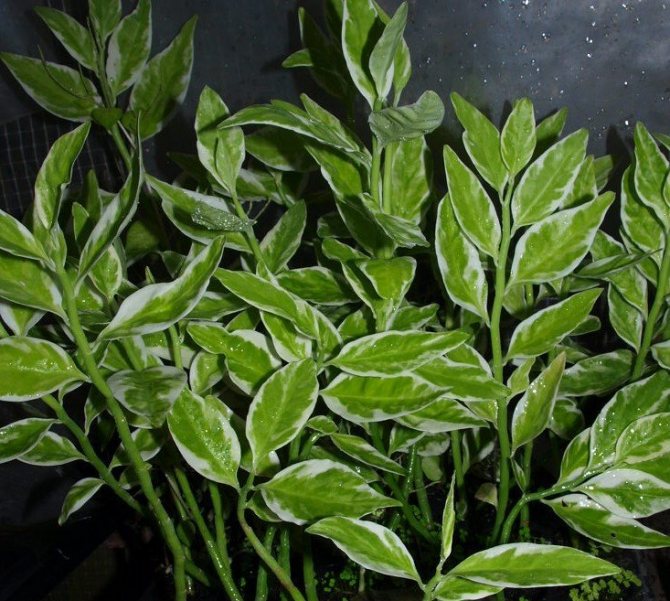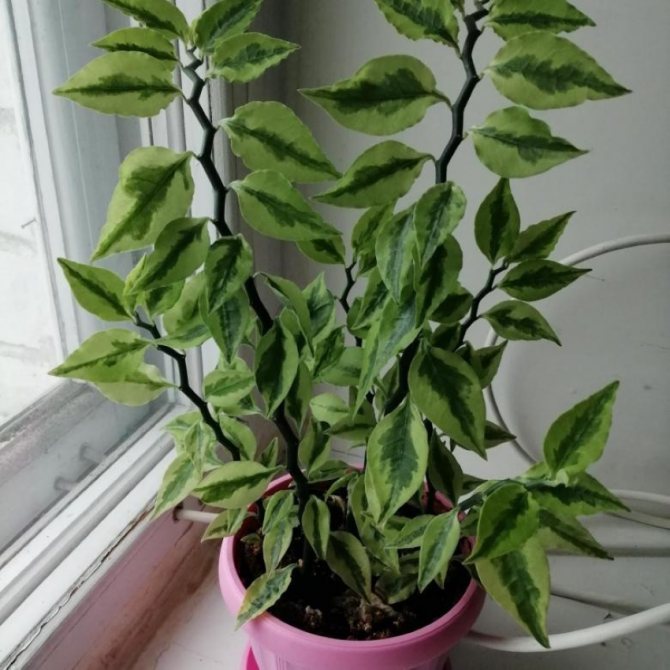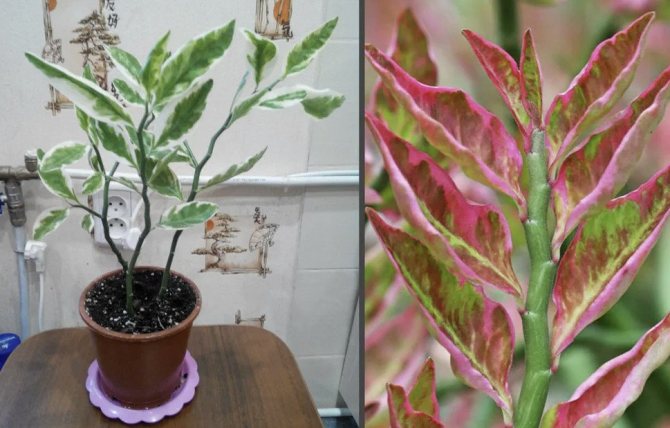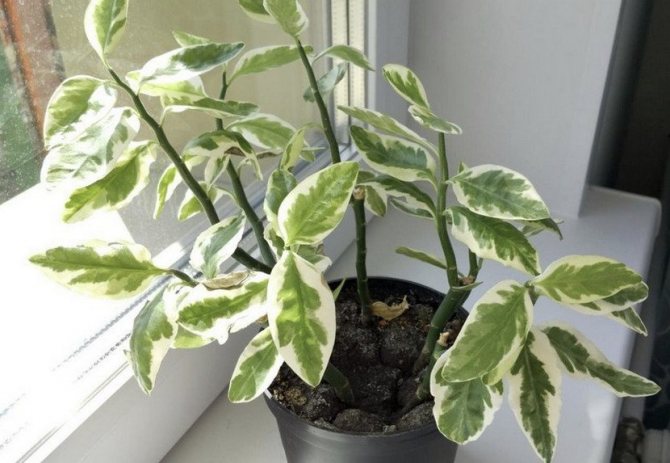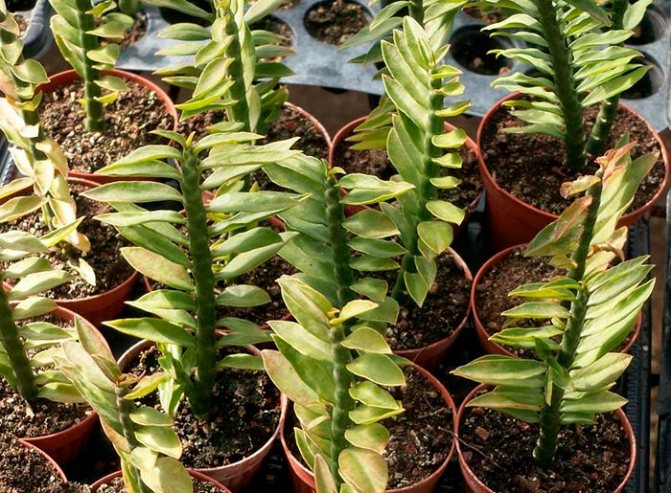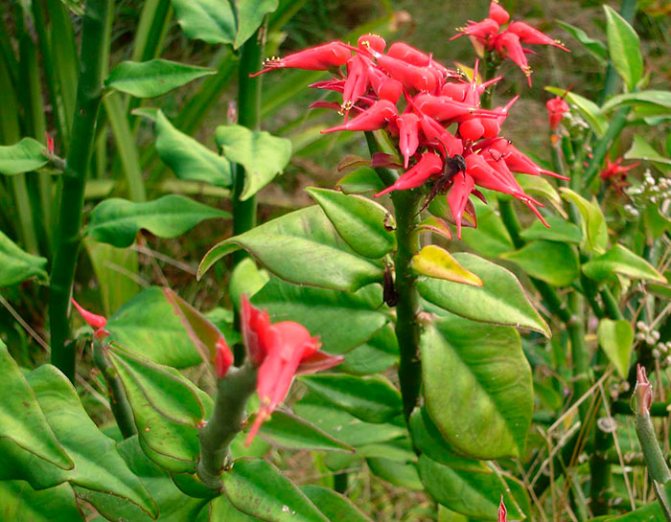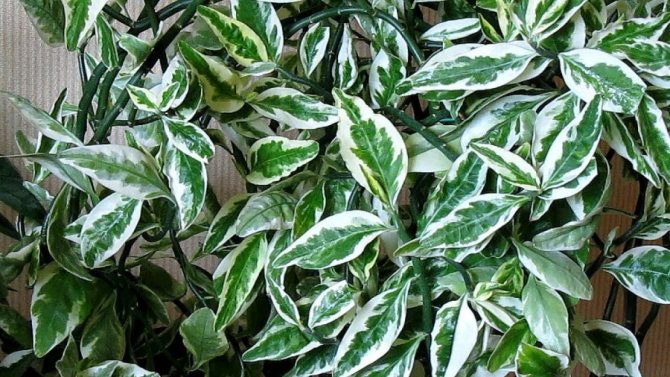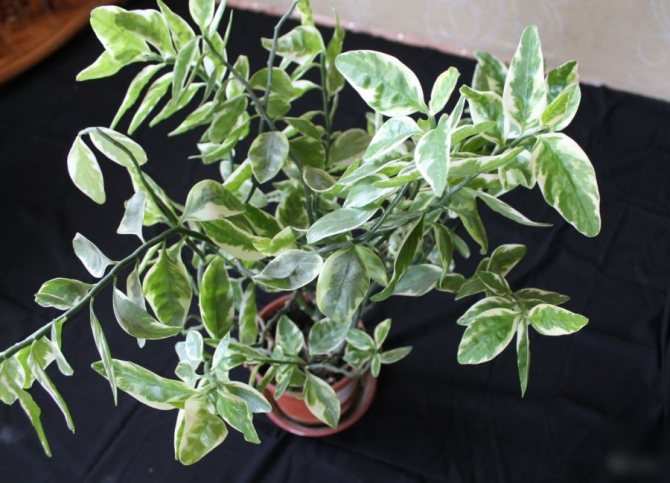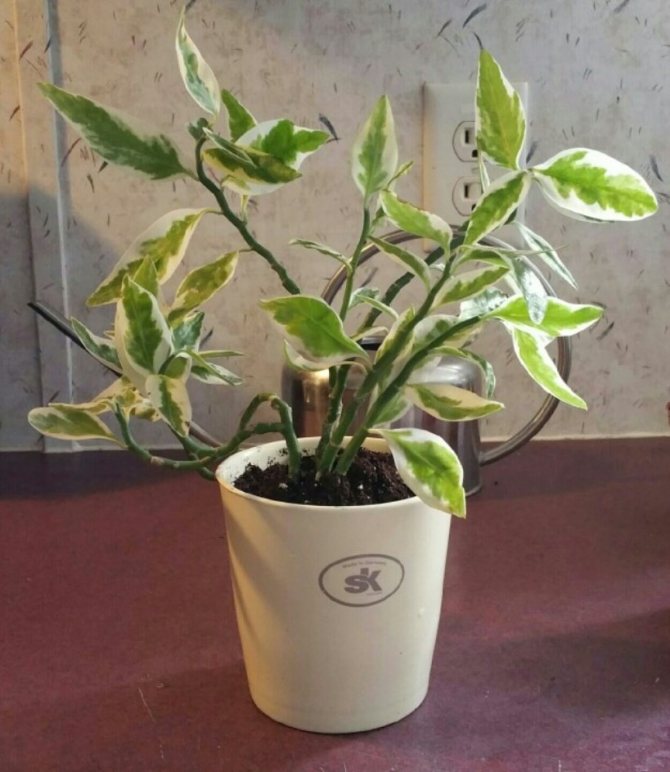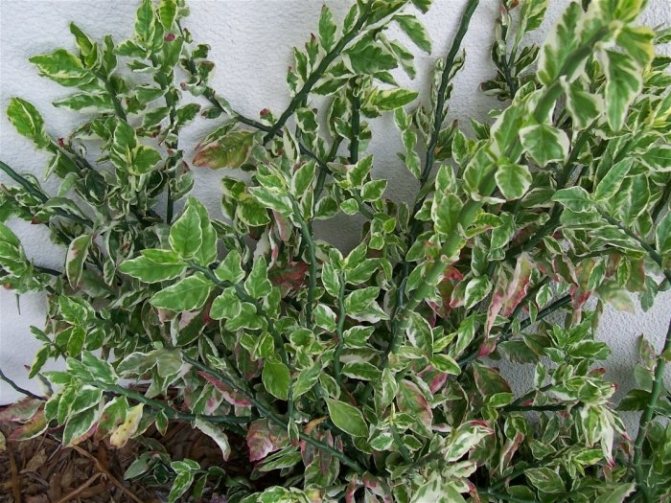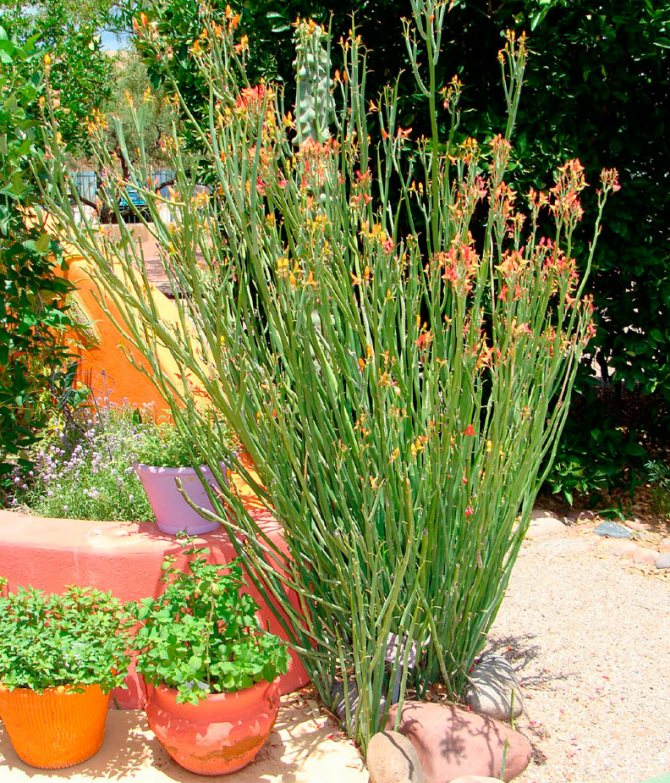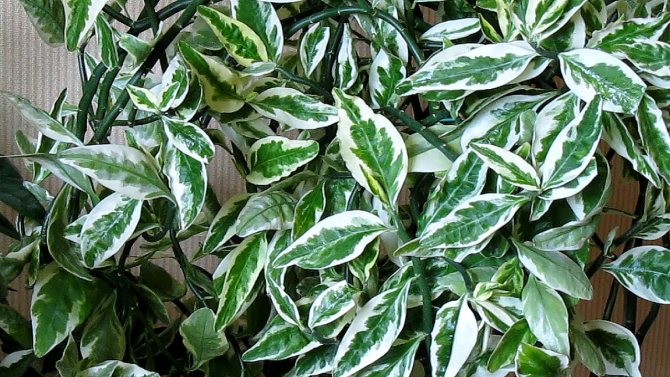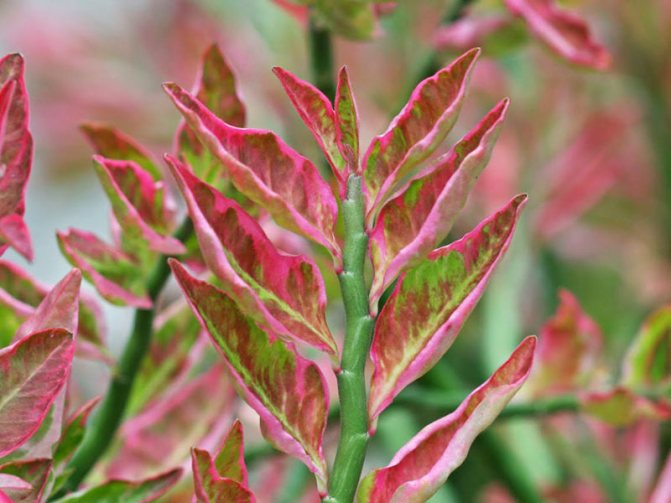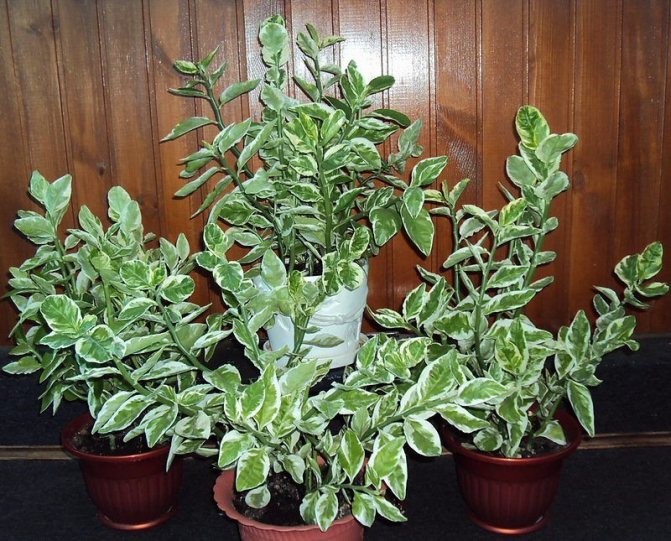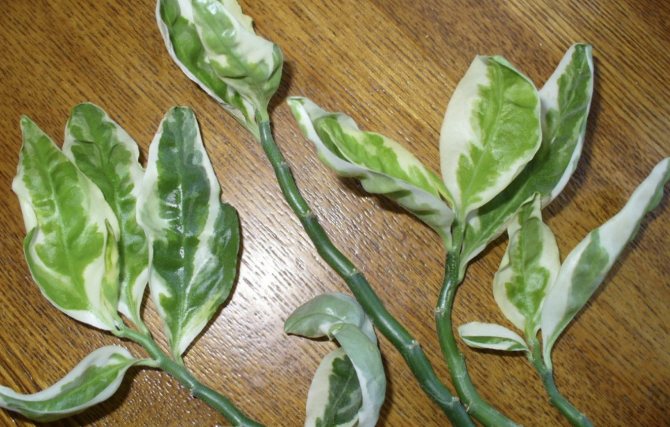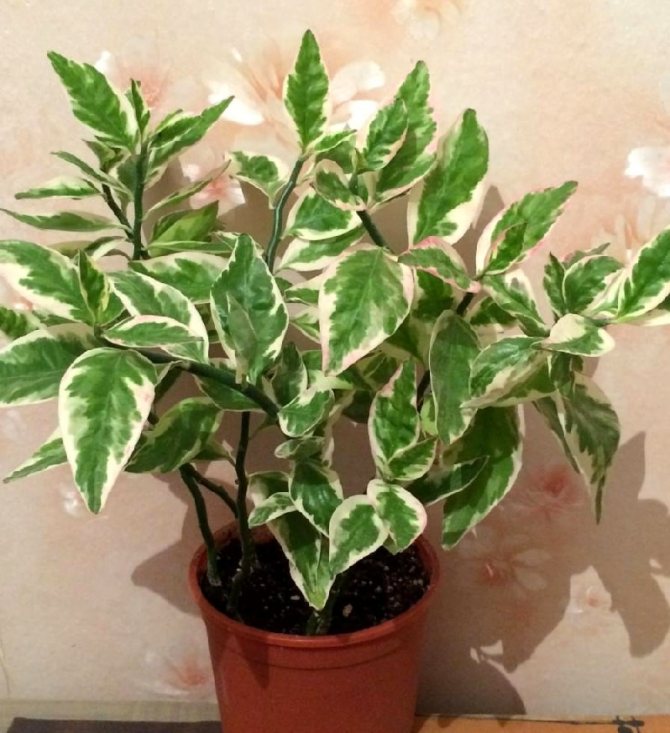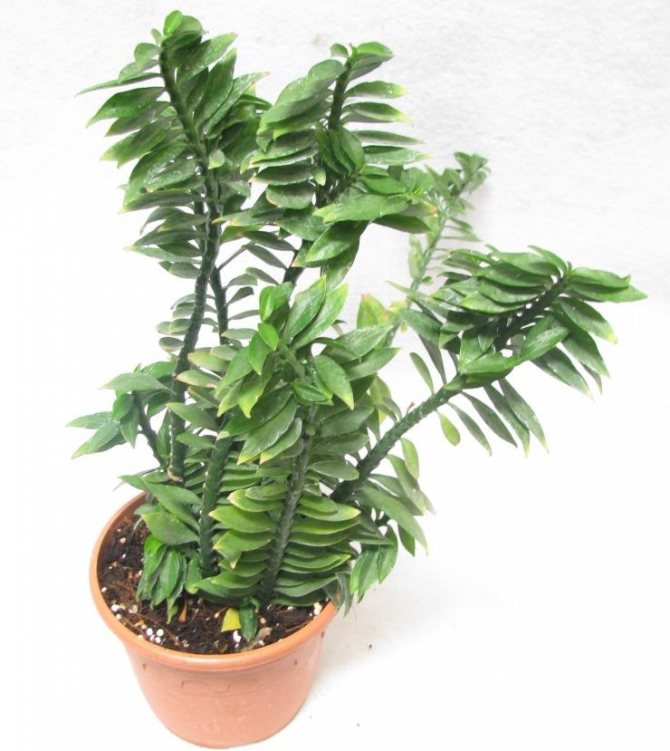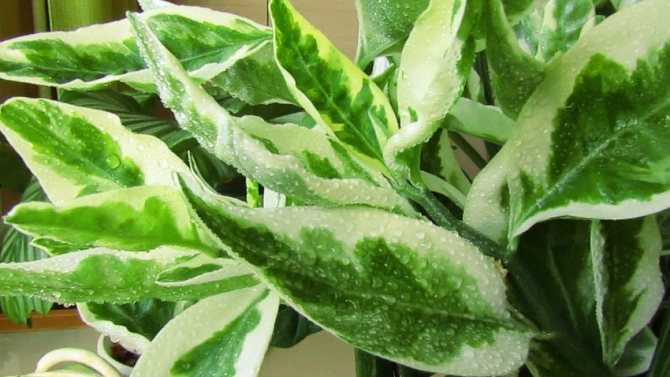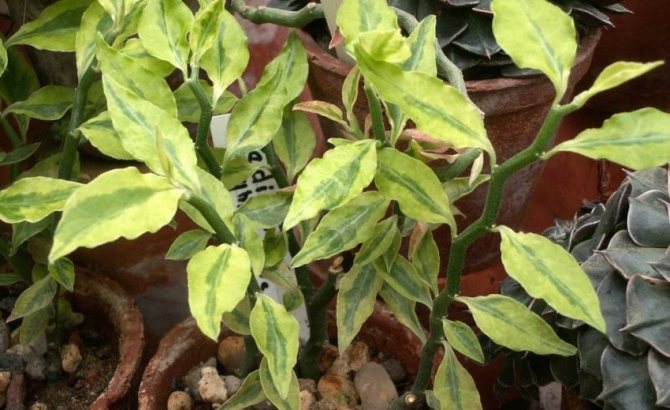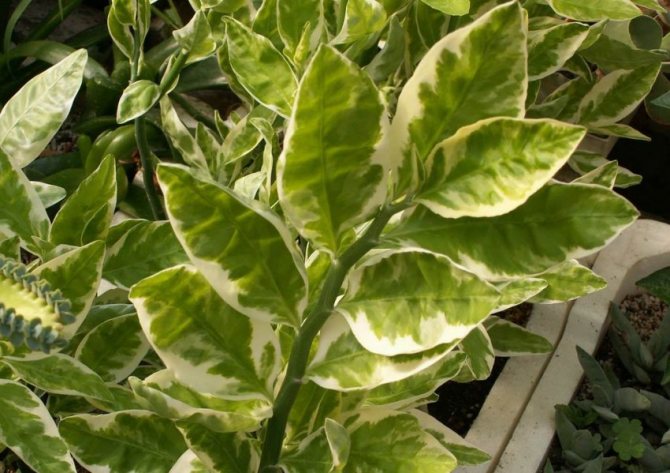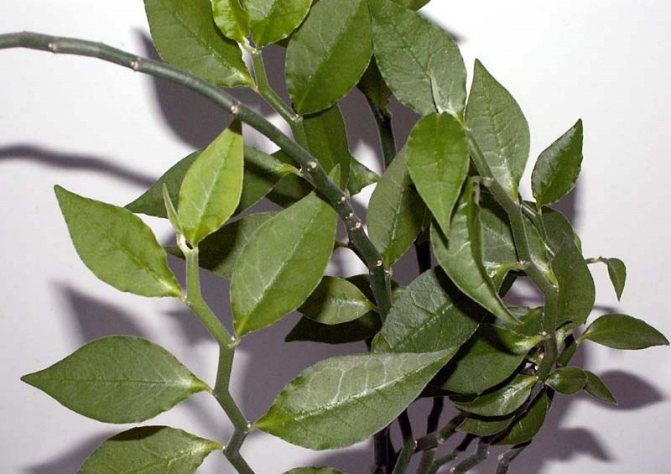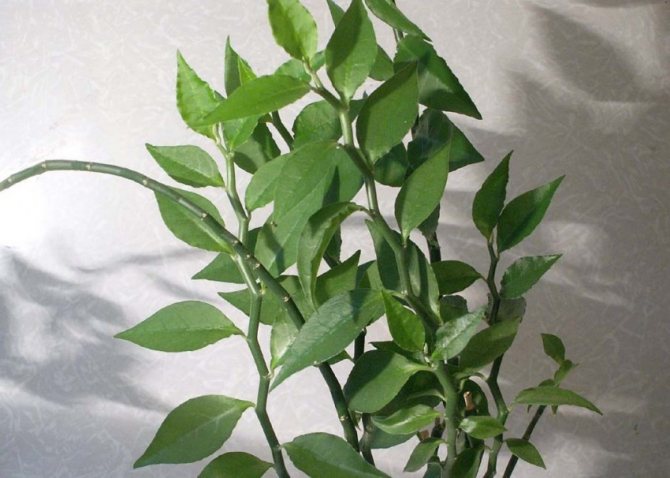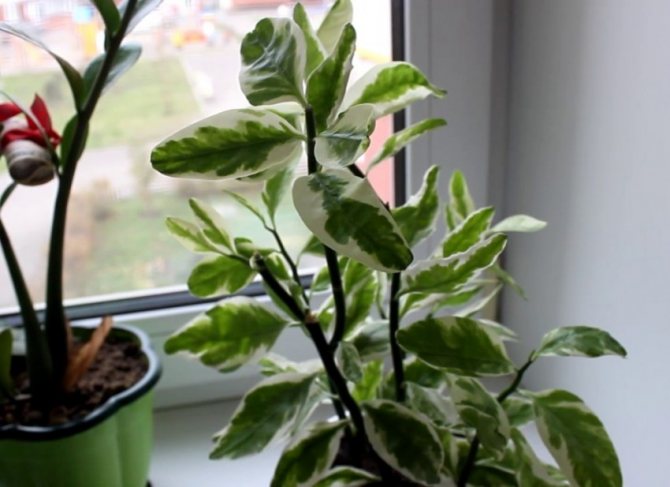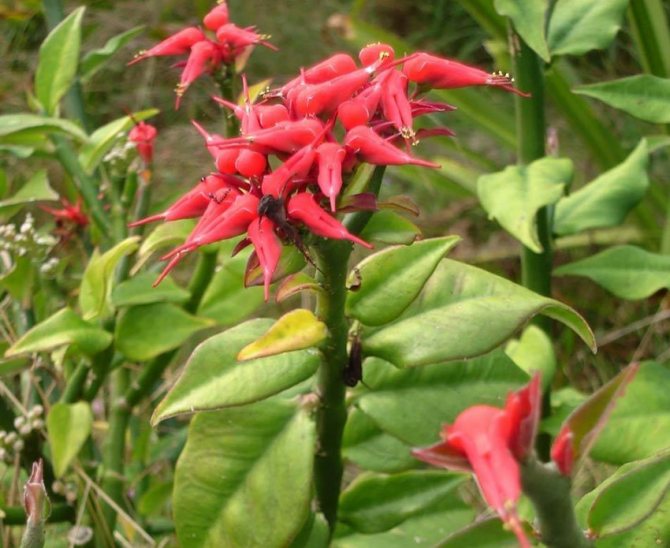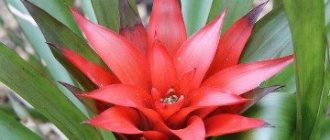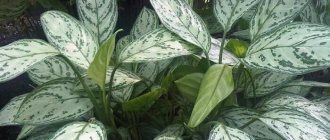Indoor flower pedilanthus titimaloid with a lush crown and decorative leaves of an elegant color is similar to an artificial composition. Its leaves and small flowers with bright bracts are covered with a waxy coating and therefore seem too smooth and shiny, as if made of plastic. Florists love a persistent and hardy plant called titimaloid pedilanthus for its unpretentious disposition, as well as its exotic appearance. Caring for him is very simple, but you need to know some of the nuances.
Description of the plant
Pedilanthus belongs to the euphorbia family. This is evidenced by the release of thick white juice from the cut. For the charming appearance of flowers, the plant also has a second name - fairy shoes. Lush inflorescence is formed by small pointed flowersreminiscent of women's pumps.
It inhabits almost the entire American continent, significantly differing in appearance depending on its proximity to the equator.
Grows as small trees in moderately humid areas.
In arid areas, the plant leafless and cactus-like, since it has a thickened stem, intensively storing water.
In tropical forests with an abundance of moisture and warmth, pedilanthus shows all its beauty: branched shrubs with dense foliage and lush color.
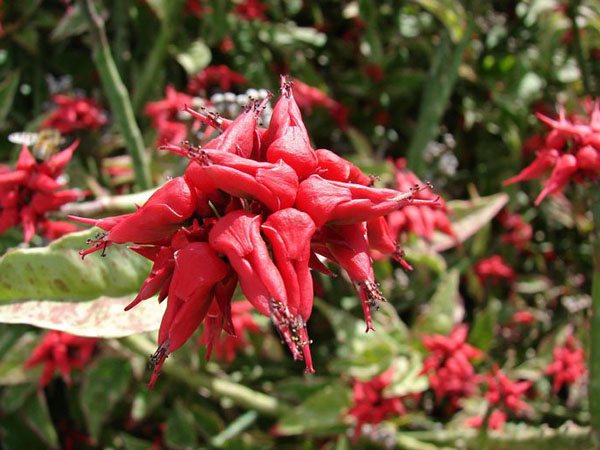
Plant sizes do not exceed 3 meters in natural conditions, and indoor varieties are characterized by low growth: they reach a maximum of 1–1.5 meters in height.
Leaves of various shapes, depending on the variety: oval or elongated, straight or wavy edge. The tip is usually pointed. The leaves are attached to the stems at the base or with a very short petiole.
The characteristic feature is copious coating of sheet plates with waxthat even resembles an artificial composition. The color of the plant is from dark olive to light green, and the edges of the leaves are edged with white patterns with jagged edges.
Important! Pedilanthus is a poisonous plant due to the presence of thick and acrid sap. All work with him should be done with gloves, and if there are children and animals in the house, then it is necessary to decide whether it is possible to keep such a flower at home and make an informed decision.
More about the flower
In nature, the culture can grow in the form of trees growing up to 3 meters, or shrubs. Indoor pedilanthus at home does not grow tall. The stems of the plant are cylindrical and are dark green or dull gray. In a culture grown in a room, the stems have a diameter of no more than 2 cm, and the height does not exceed 2 m. The leaves are green with a waxy coating, pointed, have an ovoid shape. In some species, they are pubescent. During the dormant period, the leaves may fall off. Small flowers are pink or red and are collected in apical umbrellas.


Most gardeners who have heard about superstitions and omens are worried about what pedilanthus benefits or harms to the house. The advantage of keeping the culture in the room is the purification and saturation of the air with essential oils. This culture, like other representatives of milkweed, contains poison; you cannot cut it off with your bare hands. It must be kept out of reach of pets, birds and children.
According to superstition, the culture received as a gift cannot bring wealth and happiness to the house. This also applies to the case of theft of a pedilanthus, when someone picks off a stalk. To unmarried girls, if you believe the signs, such a flower will not bring happiness, but will scare away grooms from the house.
Signs and superstitions
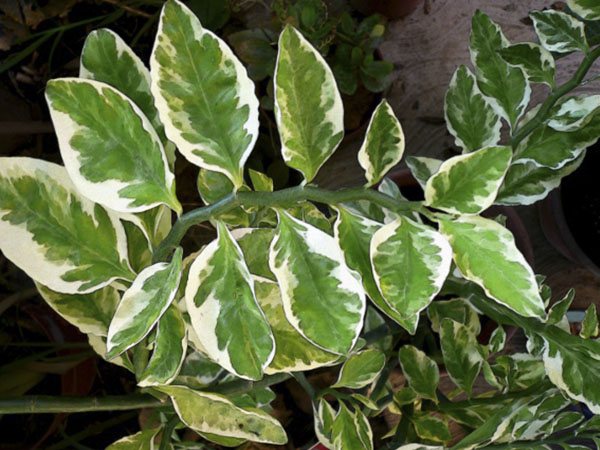

Pedilanthus well saturates the atmosphere of the room with oxygen and antiseptic essential oils. But with the appearance of such a plant in the house, many signs and superstitions are also associated:
- Acquired pedilanthus or taken by cutting from another plant portends professional growth in the present place of work or a change in the field of activity to a more profitable one.
- Flower in the office also promotes career advancement.
- The potted pedilanthus received as a gift stimulates the renovation of the interior of the house or a large-scale rearrangement.
- There is also a negative omen for unmarried girls. It is believed that pedilanthus will drive away suitors for a long time.
How does a flower propagate?
In nature, pedilanthus reproduces mainly by seeds, but getting them at home or acquiring them is rather problematic. Therefore, flower growers use apical cuttings to obtain new plants.
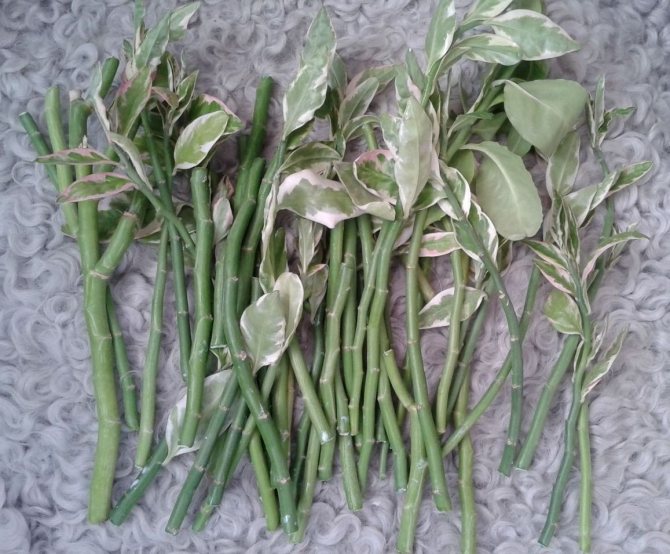

It is not difficult to obtain planting material, therefore rooting cuttings is the most popular way to reproduce a flower.
They are cut from perfectly healthy 3-4 year old plants in late spring or summer. The optimal cutting length is 8–10 cm.
- The cut planting material is dried for at least a day. The longer the stalk, the longer it takes. Maximum - 3-4 days.
- Small containers are filled with peat chips, coarse river sand, perlite, vermiculite. Cuttings are deepened into a dry substrate by 2-3 cm. It is advisable to warm it up to a temperature slightly above room temperature before planting. Another option is to lower the cuttings, removing the lower leaves, into boiled water (30–35 ° C). It will have to be changed daily.
- At the time of rooting, plants are provided with a constant temperature of 22–25 ° C, illumination with special phytolamps located at a distance of at least a meter from the pots. Do not direct light directly onto plants. You do not need to cover the containers or place them in plastic bags, otherwise the cuttings can rot. If the leaves lose their tone, lightly spray the substrate with a spray bottle.
- Roots appear in 2–3 weeks. Wait another 7-10 days and transplant the new plant into a substrate suitable for adult pedilanthus, and then take care of it as usual.


The roots of pedilanthus cuttings appear rather quickly; the main thing is to prevent the development of rot
Video: Reproduction of indoor plants by cuttings
Pedilanthus: species and varieties
One and a half dozen pedilanthuses are known in nature, only a few of them are adapted to home conditions.
Tithymaloides
The most unpretentious and widely popular variety among flower growers. In natural habitat pedylanthus titimaloid grows in rainforests, therefore, has decorative appeal and lush foliage (pictured).


Looks like a branched bush... The trunks have an interesting growth feature: the direction changes with the appearance of each new leaf, so the stem is long and wavy.
Leaves are oval in shape with a pointed end, the surface is slightly wrinkled. Attractive green coloration with variegated white edges may vary: the leaves of the pedilanthus turn pink before the buds open.
Flowering occurs before the onset of winter, which adds to the benefits of the pedilanthus genus. It blooms with small red “shoes” collected in inflorescences.
Large-fruited (macrocarpus)
This visitor from the arid Mexican deserts is completely devoid of leaves.It looks like thick stalks of light green color, fleshy to the touch due to the accumulated moisture.
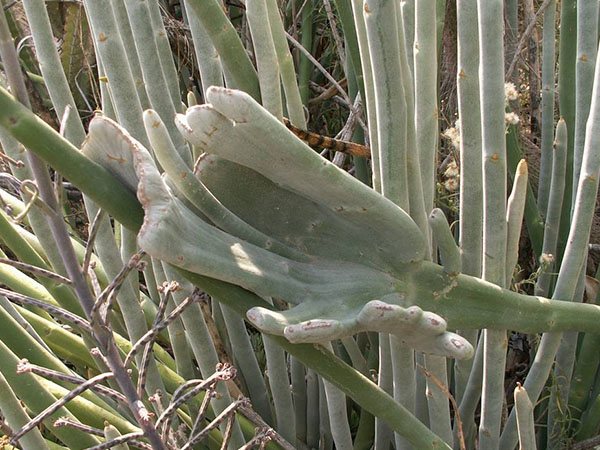

The leaves have transformed into very small scales on top of the trunks.
In late autumn, it is covered with glossy red inflorescences.
Finca (finkii)
The bushy pedilanthus has zigzag trunks that are thickened by accumulated water. Unlike the titimaloid species, leaves are bright green, devoid of contrasting border.
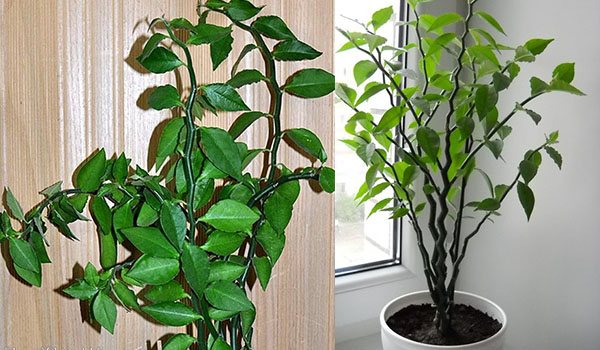

A feature of the variety is that it drops leaves from below, so the bottom half of the bush looks like a cactus, and the top half looks like a lush bush.
Finca pedilanthus lends itself well to crown formation due to pruning and abundant branching.
Spur (calcaratus)
Tall pedilanthus spur grows up to several meters in height. The dense stems have the same color as the leaves - rich green with pronounced waxy coating... The variety is picky about lighting and watering, so it should be purchased by caring flower growers.
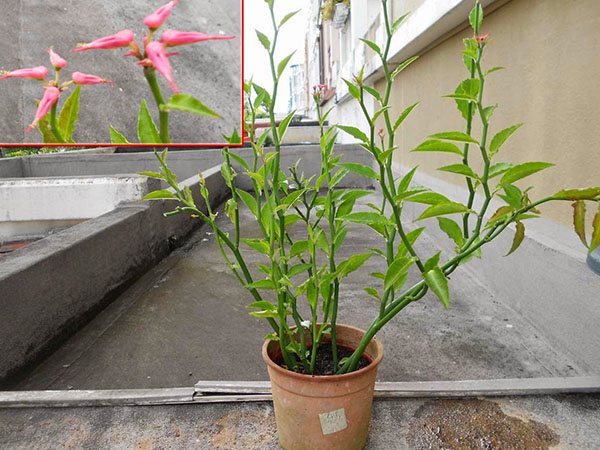

Nana
Pedilanthus Nana likes to hide under the shade of tall trees.
The thickened erect stem reaches several centimeters in circumference. Elongated leaves oval with smooth edges... They grow on opposite sides of the trunk, forming 2 even rows of leaves on the sides of the shoots.


The plant has a spectacular glossy shine.
It grows well in rooms with high humidity, and tolerates a lack of light more tolerantly.
What does the flower symbolize
Pedilanthus, due to its appearance, resembles an artificial plant. The homeland of the bush is America. In another way, the plant is called Jacob's ladder.
Pedilanthus has several varieties. The most popular type that is suitable for growing at home is called titimaloid.
Florists appreciate the bush for its properties and inherent signs. The plant has a flowering period which is also unusual. The inflorescences are similar to women's shoes, differing in different colors: from bright pink to dark red.
The appearance of the pedilanthus contributed to the popularization of the bush and the appearance of both favorable and negative signs.
Home care for pedilanthus
Pedilanthus does not require constant care, it is enough to provide it with the right conditions for full growth and flowering.
Location and lighting
The plant has a very bright appearance, so it can be safely identified in the most prominent place in the house. Moreover, thanks to him there is a constant air disinfection and oxygenation, which is most needed in the living room or bedroom.
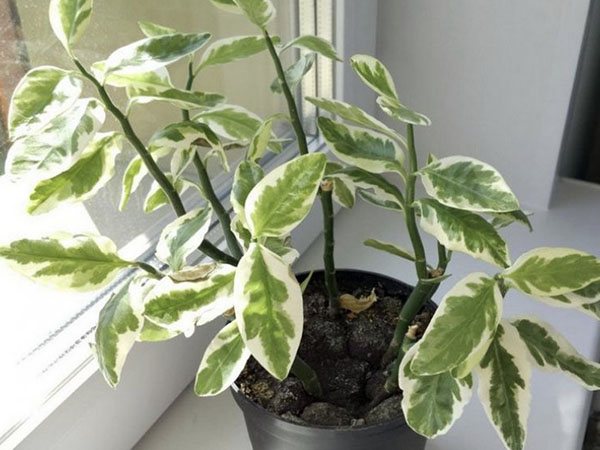

The main thing is to provide the plant with sufficient lighting throughout the year. The greatest amount of sunlight will receive on the windowsill in the southern part houses, slightly smaller - in the south-east and south-west.
For the safety of leaves in the summer the pot should be shaded at noon.
It is best to take out the pedilanthus in the summer under the shade of trees in the garden or on the balcony.
Temperature
Like any tropical plant, pedilanthus loves high air temperatures.
Its maximum figures fall on the spring and summer period, when there is intense growth - from 22 to 26 degrees. In winter, such indicators of a thermometer in an apartment can lead to leaf fall, especially if the pot is next to heating devices.
Better to lower the temperature to 15 degrees, providing a short period of rest for laying future flowers.
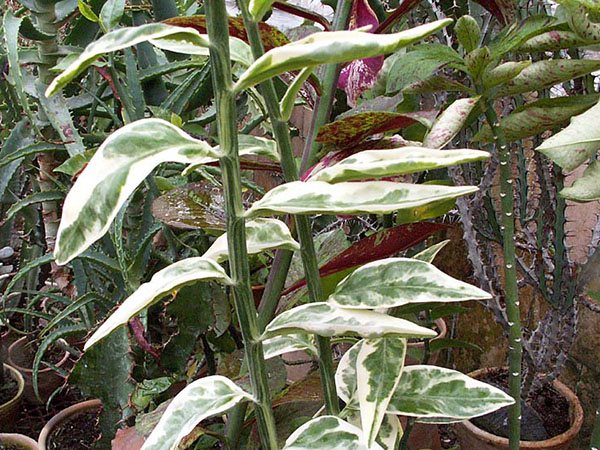

If the pot is on the windowsill, then when ventilating in winter, the plant must be protected from cold air. This will prevent frostbite on the leaves.
Humidity
Deciduous types of pedilanthus love periodic spraying... They allow you to wash away accumulated dust and improve your appearance.
In the summer, spraying is carried out more often, which contributes to better tolerance of the heat.
It is important not to shower in bright sun to protect the leaves from burns.
Watering
The main indicator by which the need for watering is determined is the loosening of the topsoil due to drying out. From the beginning of spring to the end of flowering, watering is required regular in moderation.
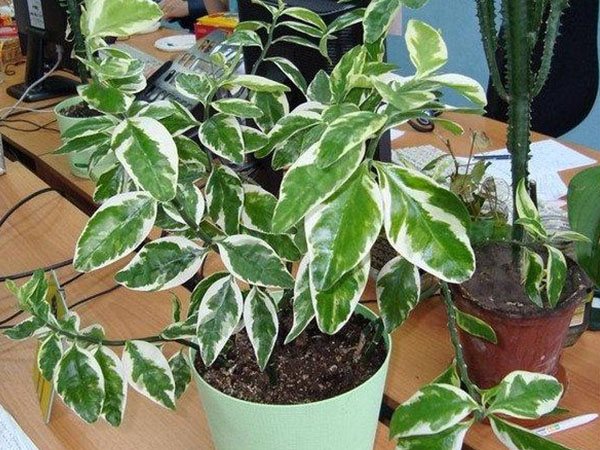

Tap water must first settle in an open container for at least a day so that chlorine evaporates from it. Hard water can be softened by adding 1 tsp to it before settling. apple cider vinegar.
Advice! If you urgently need to water the flower, and the water has not been prepared in advance, then you should at least pass it through a kitchen filter.
With a decrease in ambient temperature, the growth of pedilanthus slows down. You also need to navigate by the top layer of the soil, which now takes longer to dry - 1.5-2 weeks.
Interestingly, attentive growers may notice the need for watering on the plant itself: its leaves drop slightly. It is advisable to notice the interval between watering up to this point and moisten the soil 1-2 days earlier so that the leaves do not droop from lack of water.
Top dressing and fertilizers


Components that pedilanthus needs for life:
- calcium;
- iron;
- phosphorus.
Nitrogen, on the other hand, is required in a minimal amount. There are no ready-made fertilizers specifically for pedilanthus, but mixtures for succulents are suitable for the plant.
The soil
Loose soil is preferable, into which moisture and air easily penetrate. Suitable ready-made substrate sold for cacti, it will not be superfluous to additionally saturate it with coarse sand or perlite.
To prepare soil from several components, you will need:
- leaf and sod land in equal parts, a quarter of the volume of sand or perlite;
- universal soil for indoor plants or ordinary garden landsupplemented with sand and coconut supplement.
This video tells about the features of Pedilanthus care at home.
Pot
The material from which the pot is made (plastic, clay or ceramic) is not fundamentally important. The main thing in choosing is to match the size of the root system and the volume of the container.
A young plant needs a small pot designed for cacti. Further, it is enough to add 1–2 cm in width and depth compared to the old one.
In a pot that is too large, there will be moist soil, from which the roots cannot absorb moisture, and it will oxidize, which contributes to the appearance of harmful bacteria.
To drain excess water, drainage holes at the bottom are required.
Pedilanthus transplant
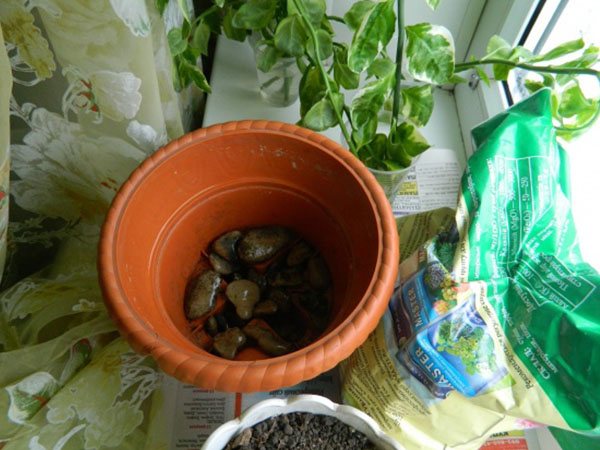

Slow root growth does not require frequent replanting. This procedure is necessary in several cases.
- Flower recently bought from the store needs to be relocated to fertile soil and a matching pot. Do not rush to transplant after the plant has entered the house. It is better to wait 2-3 weeks for the pedilanthus to adapt to the new microclimate conditions, after which it will be able to transfer the transplant.
- The pot has become too small for roots, as evidenced by the roots that are visible through the drainage holes. Also, the reason for the transplant is that several years have passed since the previous procedure.
- Root diseases.
For transplantation, a suitable substrate and pot are prepared in advance.
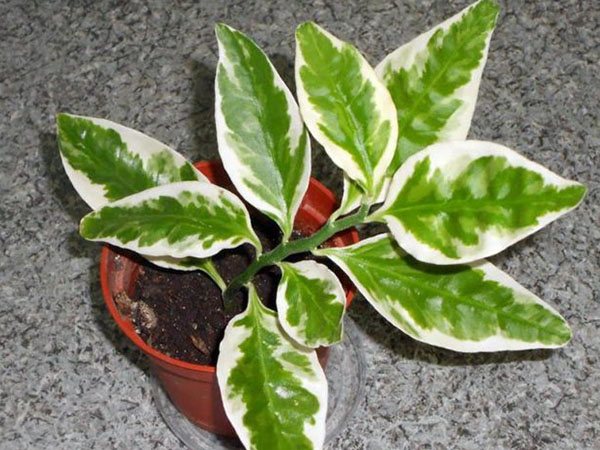

Stages of work:
- The eve the plant is good watered to easily pull out the earthy clod.
- Tap the walls a little and turn the pot down, holding the base of the pedilanthus, shake it out with the ground.
- Remove most of the soil from the roots and examine them for diseases.
- Cut damaged roots, treat with potassium permanganate solution and sprinkle with charcoal.
- Pour a drainage layer of expanded clay and a layer of new earth into a new flowerpot.
- Place the pedilanthus in the center and cover with soil from the sides, shaking occasionally to uniform filling of spaces between roots.
- Water and leave in partial shade for 5-7 days.
Pruning
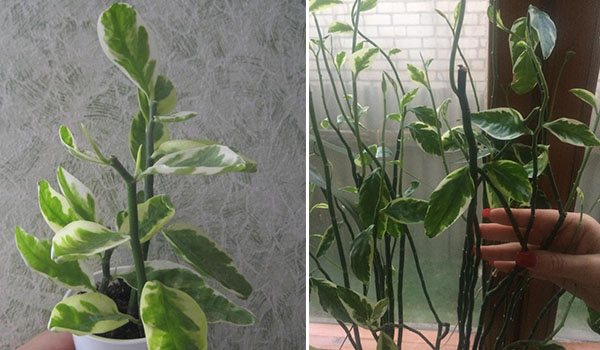

In a short period, the pedilanthus is able to significantly grow its shoots, so it must be cut off. New branches will form a lush crown... Before trimming the pedilanthus, it is important to take care of your safety by wearing gloves.
Cut off the tops of the stems, the length of which exceeds 20 cm. If the plant is given a certain crown shape, then all protruding branches from it are also removed.
Usually, pinching is carried out in the spring as new shoots grow, and pruning - before the beginning of the dormant period.
Also, the procedure may be necessary with strong leaf fall or an impressive age of an overgrown bush. With a healthy root system, it is necessary to prune, leaving 5-10 cm from the base of the shoots.
Bloom


To see the pedilanthus bloom you will have to wait about a year after landing... In order for the plant to have enough strength for the appearance of buds, it requires the following conditions:
- long daylight hours and bright lighting;
- regular and moderate watering;
- complex feeding with a minimum nitrogen content;
- winter rest in a cool place;
- healthy roots and no pests.
Flowering occurs towards the end of autumn or early winter.
How to trim a pedilanthus to shape a bush
How to crop a pedilanthus photo
- For the decorative design of the bush, systematic pruning is carried out, leaving shoots no more than 10 cm.
- The absence of formative pruning will make the plant shapeless, the shoots will stick out in different directions, depriving the flower of its decorative value.
- The first pruning is carried out after the plant reaches 20 cm, then as necessary, creating the desired appearance.
- They try to cut the longest branches, then branching often appears at the cut point, and the bush becomes thicker.
Indoors, the pedilanthus reaches a meter in height, wild species can stretch up to 2 m.
Rejuvenating pedilanthus pruning
- The plant eventually loses its decorative effect due to stretched and bare branches, in this case, rejuvenating pruning is performed.
- The flower is cut almost completely, leaving hemp of only 5-6 cm.
- Such an operation acts regeneratively, forcing the plant to go into active growth.
- After pruning, it is good to feed the flower at the root with a complex fertilizer for flowering plants.
Pruning can be combined with replanting and renewing the soil in a pot, so as not to disturb the plant once again.
Reproduction of pedilanthus
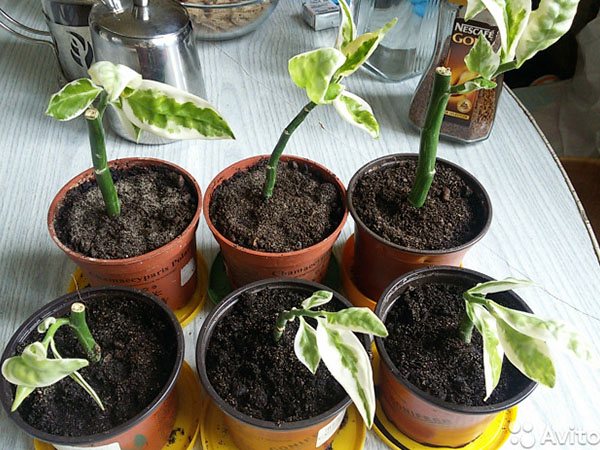

It is easy to propagate a plant after pruning a bush, and if you want to grow a new variety from seeds, you need to be patient and show dexterity.
Using seeds
Store-bought pedilanthus seeds must be sown over disinfected soil, the main part of which should be sand... For greenhouse conditions, cover moistened seeds with foil or a transparent plastic container lid.
Important! To provide oxygen and to prevent the appearance of mold, the greenhouse is ventilated daily for several minutes, spraying if necessary.
Sprouted sprouts will need bright lighting, which you need to protect from the scorching sun.
You can open the greenhouse if the sprouts are already strong. But transplanting into separate pots should not be earlier than a month after germination.
Cuttings


Propagating a succulent by seed is quite difficult, while rooting a pedilanthus is much easier.
For reproduction, the tops of the branches cut off according to the plan are suitable. The lower leaves are cut off.
It will be possible to germinate them in a glass of water.by dropping the lower third of the cutting into it. The second way is to deepen the dried cuttings into wet sand.
You will have to wait at least 3-4 weeks for rooting, and after a month the sprouts can be transplanted into permanent soil.
This video shows how to propagate Pedilanthus by cuttings.
Planting and transplanting procedure
Too often, they try not to disturb the pedilanthus, carrying out the next transplant only when the roots appear from the drainage hole of the pot. The root system develops rather slowly, so once every 3-4 years is enough even for young, fastest growing flowers. The best time to transplant is mid-spring, when the plant has already begun to form new leaves.
The pot for pedilanthus is chosen low and tight. The diameter of the new container (in comparison with the previous one) increases by 1–1.5 cm, no more, the height does not change. In general, the height and diameter of the pot should be roughly the same as each other. Of the materials, natural ceramics are preferable - they pass air and moisture well. For the same reason, a large drainage hole is important.
Pedilanthuses are planted in special soil for cacti and succulents. Or they prepare the substrate on their own. The main requirement for it is lightness, looseness, air and water permeability. Nutrition is not that important.
- Fertile turf, leafy soil, coarse river sand (1: 2: 2).
- Peat chips, universal soil for flowering houseplants, fine red brick chips, perlite or vermiculite (3: 3: 2: 2).
- Fertile turf, leaf humus, chopped coconut fiber or dry sphagnum moss (1: 1: 3).
The pedilanthus is transplanted as follows:
- Pour expanded clay or other drainage material into a new pot in a layer 2-3 cm thick.
- Fill the container halfway with fresh sterilized soil.
- Remove the pedilanthus from the old pot, gently shake the soil off the roots. You do not need to try to bare them completely or wash off the substrate.
- Carefully examine the roots, cut dry, dead, blackened, slimy to the touch with sharp disinfected scissors. Cut off not only the slightest traces of blackness on rotten ones, but also an additional 3-5 cm. Most likely, pathogenic fungi have spread there as well.
- Place the flower in a new pot, add soil around the edges. Shake the container several times, lightly water the plant.
- For 7-10 days, remove the pedilanthus in a warm, dark place. This will help minimize stress and help you settle in better. Then return the pot to where it was before, and care for the plant as usual.


Store-bought pedilanthuses should be transplanted as soon as possible.
Succulents look very impressive in florariums. If you have a suitable glass container of the right size, such a composition is easy to create yourself.
- Thoroughly wash and disinfect the selected vessel by rubbing it inside and out with alcohol. Sterilize the substrate.
- Pour drainage on the bottom of the container with a layer of 1–1.5 cm, then the same amount of sifted wood ash, powdered activated carbon. If it's large enough, you can put in a few pieces of charcoal without crushing it. It is an effective protection against mold and rot.
- Pour the substrate over. The thickness of the layer depends on the depth of the container (from 2 cm and more). Level the soil, prepare the pedilanthus hole.
- Rinse the roots of the selected plant, soak in 1% solution of any fungicide for 10-15 minutes. When the root system is dry, you can plant it.
- Moisten the soil slightly using a long-nosed watering can or a regular syringe.
- Decorate the composition. For decoration, multi-colored sand or pieces of glass, pebbles, pebbles, moss, fragments of bark, small figurines are suitable.
- Use a soft brush to brush the glass from the inside, removing particles of soil.
If the florarium is closed, do not forget to periodically remove the lid, especially if condensation has already formed on the walls. High humidity provokes the development of rot. It is much more destructive for the composition than excessive dryness. Therefore, plants are rarely watered and little by little.
The florarium does not last forever, although succulents grow rather slowly. Even regular cropping won't help to keep the composition forever. The overgrown pedilanthus capacity must be planted in a timely manner in pots of suitable size.
Pedilanthus diseases and home growing problems
Improper watering is manifested by the lack of flowering. Due to the lack of moisture, the plant does not have enough strength to set color, and the excess can provoke rotting of the root system and leaf discharge.
After regular fertilization, you may notice that the leaves are falling off, but not all growers know what to do with this. The reason is often nitrogenous substances in the top dressing, the excess of which causes root decay and can lead to the death of the plant.
Lack of light is manifested by significant stretching of shoots... Because of this, the pedilanthus loses its attractiveness, the leaves turn pale.
Blackness on stems and leaf plates is a signal of excessive watering or soil compaction. It is required to immediately remove the damaged parts and transplant the plant into a suitable substrate.
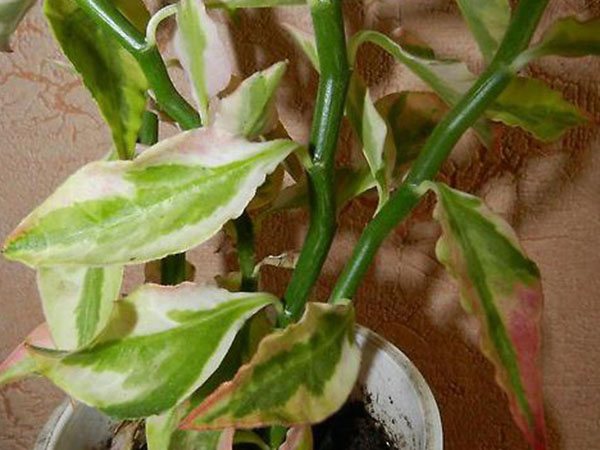

How to avoid the consequences predicted in the signs
To avoid the implementation of unfavorable signs, pedilanthus must be carefully looked after:
- keep in a comfortable temperature of about 25 ° C in summer and 15 ° C in winter;
- provide adequate lighting and no direct sunlight;
- water exclusively with settled water (room temperature);
- choose soil for both succulents and cacti.
Adequate care of Jacob's ladder will avoid plant death and bad omens.
Temperature regime
Like all succulents, Pedilanthus tolerates heat well. In the phase of active growth, the temperature in the room with the flower should be at least 22 ° C.


The optimum value is 26 ° C. The dormant period occurs during the winter months. At this time, the air temperature should be lower and be 15-17 ° C. Violation of the regime will lead to the fact that the pedilanthus will not bloom in the next season.


Do not place a bush near a battery, as hot dry air can cause leaves to fall off. In addition, the plant needs regular ventilation.


Growing errors
- There is no flowering - the flower did not rest, the conditions of winter maintenance were violated, for example, watering was not reduced or fertilizers were applied. Also, the cause can be a constant draft or poor lighting.
- Leaves turn pink - partial pinking of the leaves is the norm, especially when the flower is in the open sun. They will never change completely to pink.
- Leaves fall - in winter this is also the norm if the loss does not exceed 50% of all foliage. If leaves fall during the active growing season, you should check the recommended growing rules and find an error. Most likely, the reason lies in the violation of watering rules or in a sharp change in temperature.
Lighting and location selection
Succulent is quite light-requiring. The optimal place for him is a southern, western or eastern window sill. It should be shaded from the bright rays of the midday sun.


In the spring-summer season, it is better to take the plant out into the garden or on the balcony. In this case, it is imperative to provide protection from precipitation and provide diffused lighting.



